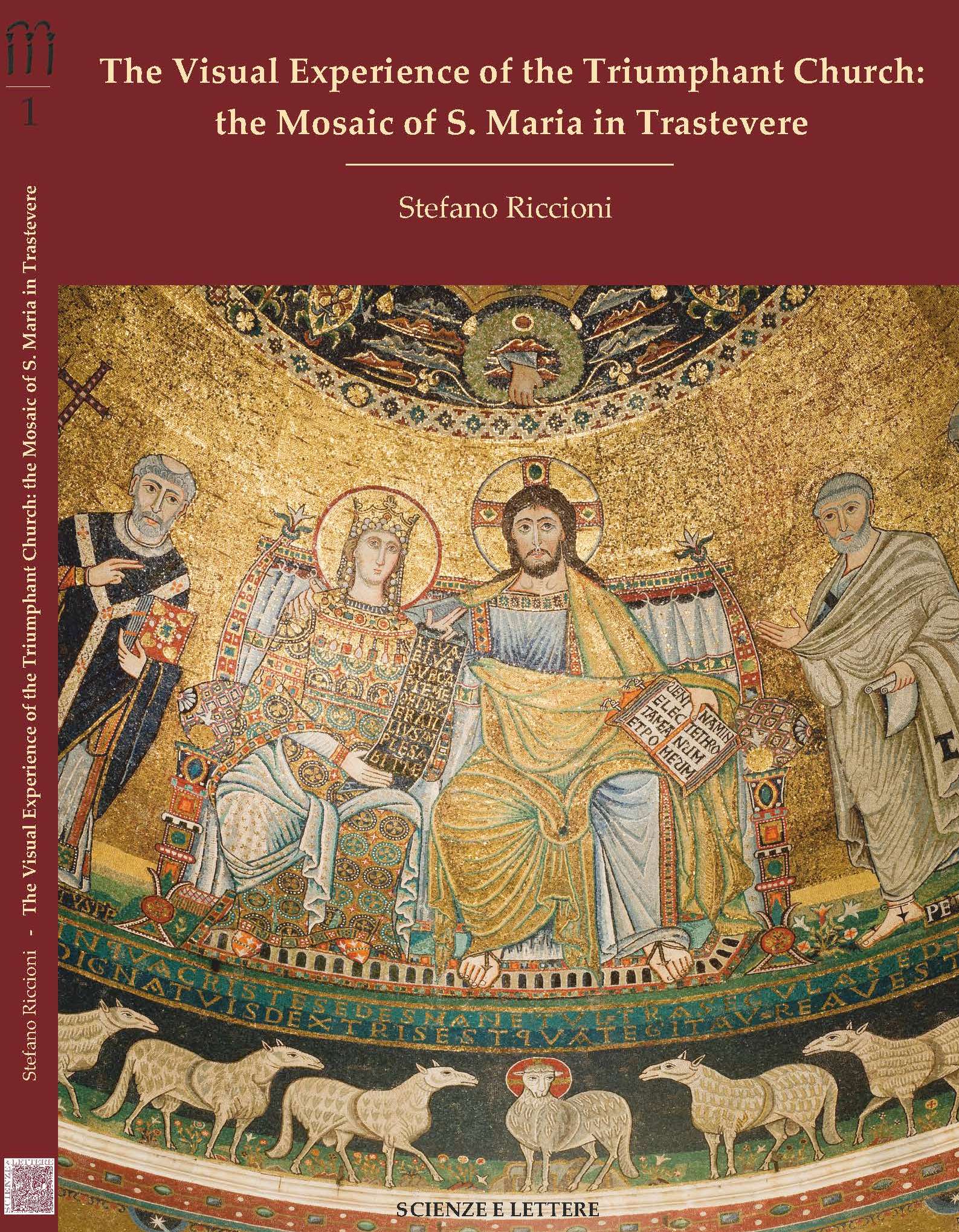The Visual Experience of the Triumphant Church: the Mosaic of S. Maria in Trastevere - Monumenta Mediaevalia 1
- Anno: 2021
- Autore/i: Stefano Riccioni
- Catalogo: Scienze e Lettere
- Argomento: Arte
- Collana: Monumenta Mediaevalia
- ISBN: 978-88-6687-015-9
- ISSN:
The church of S. Maria in Trastevere was constructed after the Concordat of Worms (1122), at a time when the original ideals of the Church Reform of the eleventh and twelfth centuries were being replaced by a new strategy intended to demonstrate the power of the papacy.
The city of Rome and the Church were emerging from a difficult period of conflict culminated in the schism provoked by the double election of Innocent II and Anacletus II as pope, an event that deeply marked the church of S. Maria in Trastevere and its decoration. During the Reform of the Church, significant changes took place in visual language, in its processes of elaboration and creation, as well as in the theoretical debates that reflect the historical, political, and cultural changes that involved all of medieval European society.
The apse mosaic of S. Maria in Trastevere provide important evidence to understand this transitional period for the Roman Church.
ACKNOWLEDGMENTS
INTRODUCTION?
CHAPTER 1
FRAMING THE CHURCH REFORM IN ROME
1.1. The ‘Gregorian’ Reform
1.2. Anacletus II and Innocent II
1.3. The Arts and the Church Reform
1.3.1. Rome: the Model
1.3.2. Outside Rome
1.4. The Visual Experience
CHAPTER 2
S. MARIA IN TRASTEVERE
2.1. Historical Sources
2.2. Architecture, Restoration, and Conservation
2.3. Mosaic Conservation
CHAPTER 3
THE MOSAIC DECORATION
3.1. Apse Arch: the Apocalypse and the Prefiguration of Christ
3.2. Inscriptions
3.3. Rethinking Antiquity - The Amorini
3.4. The Intrados
CHAPTER 4
THE MOSAIC DECORATION: APSE CONCH
4.1. The Glory of the Triumphant Church
4.2. The Symbolic Sky and the Shadow
4.3. The Central Message: Visualizing the Church
4.4. Speaking Images of Cantica Canticorum
4.5. The Mosaics of the Cavetto. The Echo of a Nuptial Procession?
CHAPTER 5
THE APSE CONCH: EXPERIENCING THE VISUAL MESSAGE
5.1. The Feast of the Assumption
5.2. The Image of Mary
5.3. The Icon of Christ
5.4. The ‘Codex’ and the ‘Volumen’ as the Visual Voice of Christ and Mary
5.5. The Image of St. Peter, between Antiquarianism and Papal Symbol
5.6. Saints, Martyrs, and Popes: The Eulogy of Trastevere
5.6.1. The Ecclesiastical Garments
CHAPTER 6
THE RHETORIC OF COLORS
6.1. The Arms of the Church on the Triumphal Arch
6.2. The Color of the Frames
6.3. The Colors of the Clothes and the ‘Poetry’ of Light
6.4. The Connecting Labels
CHAPTER 7
THE INSCRIPTION IN THE APSE AS EXEGETICAL SYNTHESIS OF THE DECORATION
7.1. The Rhetorical Experience of the Triumphant Church
MANUSCRIPTS AND DRAWINGS
BIBLIOGRAPHY
ILLUSTRATIONS
Stefano Riccioni, MA and PhD in Medieval art history (University of Florence and La Sapienza University of Rome), was awarded the Licence in Mediaeval Studies (Pontifical Institute of Mediaeval Studies of Toronto). He hold fellowships and invitations from various Italian and foreign research institutions including the Ecole Française de Rome, The Getty Foundation of Los Angeles, the Kunsthistorishes Institut in Florenz, and was assistant professor at the Scuola Normale Superiore of Pisa. He is currently Associate Professor of History of Medieval Art at the University Ca' Foscari of Venice.
Stefano Riccioni’s main research interests are in Medieval Art History, Medieval Epigraphy and the Mediterranean area as a center of cultural exchange between East and West. His most influent scientific contributions deal with case studies linked to: theory and artistic and graphic production during the Church Reform (11th-12th cent.) in Rome and Europe; signatures of medieval artists as an insight into their literacy and 'culture'; History of Art and conservation of Cultural Heritage in Armenia and Subcaucasia; visual representations of animals (monumental Bestiary); artistic production in Venice and the Adriatic area (9th-14th century); relationships between publishing, exhibitions and museums. He published and edited several scientific papers and books, among others: Il mosaico di S. Clemente. Exemplum della Chiesa riformata (Spoleto, 2006) and L'Arte Armena. Storia critica e nuove prospettive, edited by Aldo Ferrari, Stefano Riccioni, Marco Ruffilli and Beatrice Spampinato (Venice, 2020).



